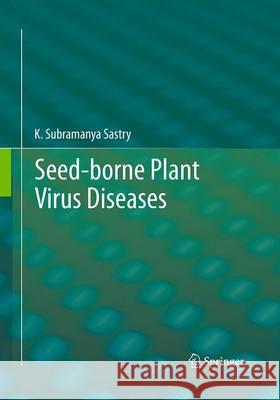Seed-Borne Plant Virus Diseases » książka



Seed-Borne Plant Virus Diseases
ISBN-13: 9788132228516 / Angielski / Miękka / 2016 / 328 str.
Seed-Borne Plant Virus Diseases
ISBN-13: 9788132228516 / Angielski / Miękka / 2016 / 328 str.
(netto: 575,06 VAT: 5%)
Najniższa cena z 30 dni: 578,30
ok. 22 dni roboczych
Dostawa w 2026 r.
Darmowa dostawa!
This book provides complete details on seed transmitted virus and viroid diseases at the global level including, the yield losses, diagnostic techniques, mechanism of seed transmission, epidemiology and virus disease management aspects.
Preface.-Acronyms.-I INTRODUCTION.-1.1Introduction.-1.2 Seed transmission of viruses.-1.3 Seed transmission of Partitiviridae.-1.4 Seed transmission of viroids.-1.5 Viruses erroneously listed as seed-transmitted.-II IDENTIFICATION AND TAXONOMIC GROUPS.-2.1 Identification.- 2.2 Classification of viruses.-2.3 Variability in certain seed – transmitted viruses.-III ECONOMIC SIGNIFICANCE OF SEED - TRANSMITTED PLANT VIRUS DISEASES.-3.1 Introduction.-3.2 Assessment of crop losses.- 3.3 Viruses and seed viability.-3.4 Factors affecting yield losses.- IV VIRUS TRANSMISSION.-4.1 Vector transmission.-4.2 Non-vector transmission.- V MECHANISM OF SEED TRANSMISSION.- 5.1 Embryology and development of seed structure.-5.2 Distribution of virus in the seed.- 5.3 Virus longevity in seeds.-5.4 Genetics of seed transmission.-5.5 Factors influencing rate of seed transmission.-5.6 Reasons for failure of seed transmission.- VI DETECTION OF PLANT VIRUSES IN SEEDS.-6.1 Introduction.-6.2 Biological methods.- 6.3 Physical methods.- 6.4 Serological techniques.- 6.5 Biotechnology/molecular biology based virus diagnosis.- 6.6 Molecular markers.-VII ECOLOGY AND EPIDEMIOLOGY OF SEED-TRANSMITTED VIRUSEs.-7.1 Introduction.-7.2 Host plant.-7.3 Vector.-7.4 Pollen transmission.-- 7.5 Viruses.-VIII METHODS OF COMBATING SEED-TRANSMITTED VIRUS DISEASES.-8.1 Introduction.-8.2 Avoidance of virus Inoculum from infected seeds.- 8.3 Reducing the rate of virus spread through vector management.- 8.4 Integrated cultural practices for seed transmitted virus disease management.-8.5 Crops hygiene.-8.6 Control of the vectors.-8.7 Virus avoidance.- .-8.8 Resistance.-8.9 Immunization.-8.10 Approved seed certification standards.- 8.11Stages of seed multiplication.-8.12 Inoculum threshhold.-8.13 International seed testing association (ISTA).- 8.14 Seed certification against plant virus diseases.-8.15 Quality control of bulk seed lots.- 8.16 World Trade Organization (WTO) regime and its implications.- 8.17 The role of plant biosecurity in preventing and controlling emerging plant virus disease epidemics.- 8.18 Pest risk analysis (PRA).-8.19 Biosafety.-8.19.1 Biosafety regulations.- 8.20 Risks associated with genetically modified crops.-8.21 Quarantines .-8.22 Role of FAO / IBPGR in germplasm exchange.-8.23 Steps in technical recommendations for “Seed germplasm” exchange in the country of origin or destination.-8.24 Part of the planting material to be tested and post-entry quarantine.-8.25 Exclusion of exotic plant viruses through quarantine.-8.26Challenges in diagnosis of pests in quarantine quarantine.-8.27 Quarantine for germplasm and breeding material.-8.28 Role of IPGRI and NBPGR in germplasm maintenance and exchange.- 8.29 Important cases of introduction.-8.30 Important diseases restricted to some countries.- 8.31Effective methods of plant importations.- 8.32General principles for the overall effectiveness of quarantines.-8.33 Quarantine facilities.-8.34 Need for networking for the developing countries.-8.35 Perspectives.-8.36 Biotechnology and virus-derived resistance.-Molecular approachestted viruses.-IX PLANT VIRUS TRANSMISSION THROUGH VEGETATIVE PROPAGULES (ASEXUAL REPRODUCTION).-9.1 Different vegetative propagative plant materials.-9.2 Role of vegetatively propagated plant materials in virus spread.-9.3 Different virus / phytoplasma and viroid diseases.-9.4 Virus transmission.-9.5 Yield losses.- 9.6 Virus diagnosis.- 9.7 Vegetatively transmitted plant virus and virus-like disease management by certification schemes.- 9.8 IPGRI'S role in controlling virus diseases in fruit germplasm.- X FUTURE STRATEGIES AND CONCLUSIONS.-10.1 Introduction.- 10.2 Plant virus management by integrated approach.-10.3 Challenges for the future.
Prof. K. S. Sastry, Ph.D., is a plant virologist at Indo-American Hybrid Seeds (India) Pvt. Ltd. , Channasandra Village, Bangalore 560 061 (India). He obtained his M.Sc. (Botany) and Ph.D. (Botany) with plant virology specialization in 1966 and 1973, respectively, from Sri Venkateswara University, Tirupati (India). He joined Indian Council of Agricultural Research (ICAR) as a scientist (Plant Virology) during the year 1971 and retired in 1999. He has served at Indian Institute of Horticultural Research, Hessaraghatta, Bangalore 560 089, Karnataka, and also at Directorate of Oil Seeds Research, Hyderabad 500 080, Andhra Pradesh. Prof. Sastry’s research has been primarily on epidemiology and management of virus and virus-like diseases of Horticultural and Oil Seed crops. He has done pioneer research on Begomoviruses of Tomato and Okra. He has research experience in molecular and biotechnological approaches for characterization and control of viral diseases of horticultural crop plants. Further, he has also published over 120 research papers both in national and international journals. He has also published “Compendium of the Plant Virus Research in India (1903-2008)” having 8652 plant virus references that is considered as one of the rich sources of information for Indian plant virus research.
Seeds provide an efficient means in disseminating plant virus and viroid diseases. The success of modern agriculture depends on pathogen free seed with high yielding character and in turn disease management. There is a serious scientific concern about the transmission of plant viruses sexually through seed and asexually through plant propagules. The present book provides the latest information along with the total list of seed transmitted virus and viroid diseases at global level including, the yield losses, diagnostic techniques, mechanism of seed transmission, epidemiology and virus disease management aspects. Additional information is also provided on the transmission of plant virus and virus-like diseases through vegetative propagules. It is also well known that seed transmitted viruses are introduced into new countries and continents during large-scale traffic movements through infected germplasm and plant propogules. The latest diagnostic molecular techniques in different virus-host combinations along with disease management measures have been included. The book shall be a good reference source and also a text book to the research scientists, teachers, students of plant pathology, agriculture, horticulture, life sciences, green house managers, professional entrepreneurs, persons involved in quarantines and seed companies. This book has several important features of seed transmitted virus diseases and is a good informative source and thus deserves a place in almost all university libraries, seed companies and research organizations.
1997-2025 DolnySlask.com Agencja Internetowa
KrainaKsiazek.PL - Księgarnia Internetowa









